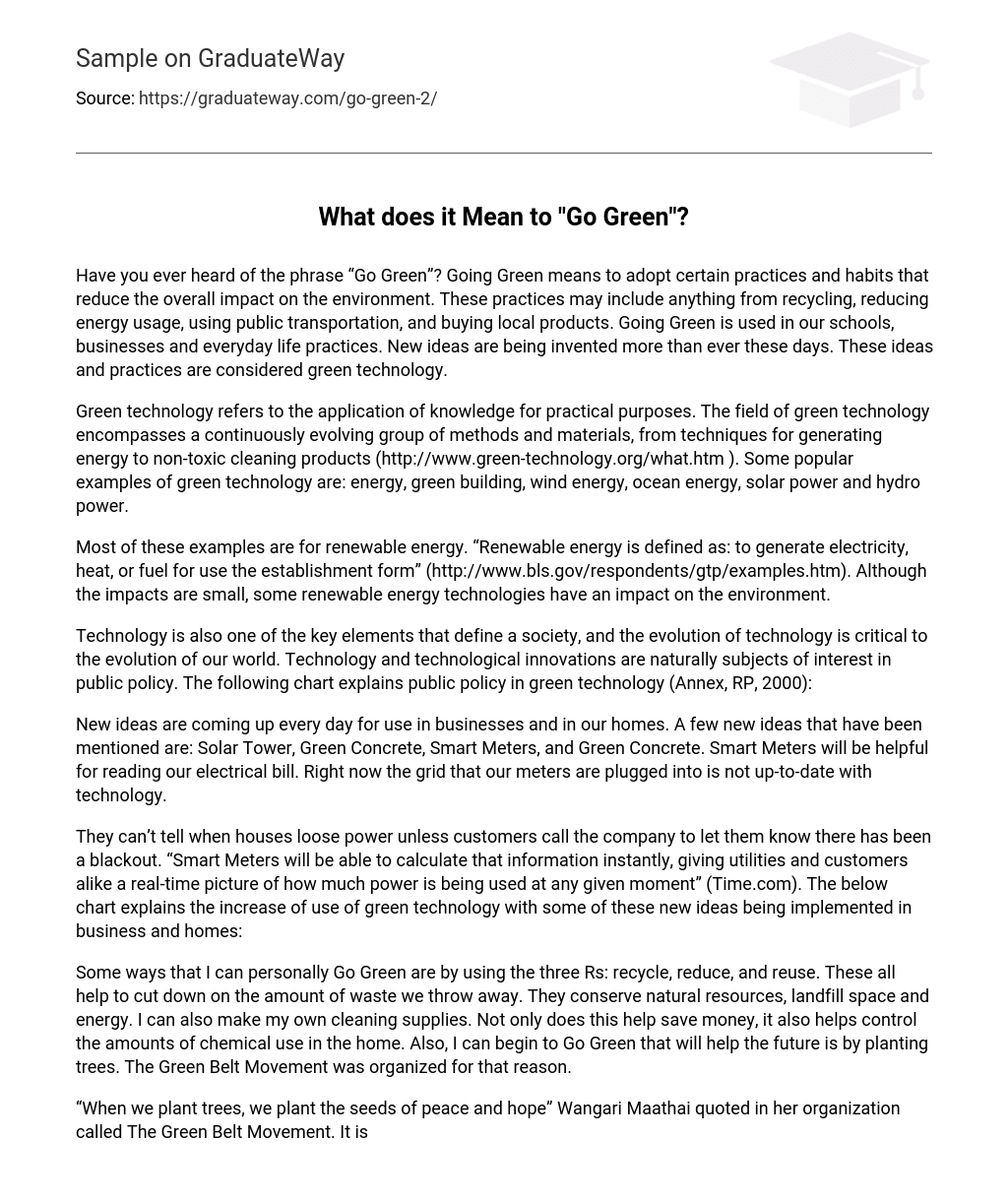Have you ever heard of the phrase “Go Green”? Going Green means to adopt certain practices and habits that reduce the overall impact on the environment. These practices may include anything from recycling, reducing energy usage, using public transportation, and buying local products. Going Green is used in our schools, businesses and everyday life practices. New ideas are being invented more than ever these days. These ideas and practices are considered green technology.
Green technology refers to the application of knowledge for practical purposes. The field of green technology encompasses a continuously evolving group of methods and materials, from techniques for generating energy to non-toxic cleaning products (http://www.green-technology.org/what.htm ). Some popular examples of green technology are: energy, green building, wind energy, ocean energy, solar power and hydro power.
Most of these examples are for renewable energy. “Renewable energy is defined as: to generate electricity, heat, or fuel for use the establishment form” (http://www.bls.gov/respondents/gtp/examples.htm). Although the impacts are small, some renewable energy technologies have an impact on the environment.
Technology is also one of the key elements that define a society, and the evolution of technology is critical to the evolution of our world. Technology and technological innovations are naturally subjects of interest in public policy. The following chart explains public policy in green technology (Annex, RP, 2000):
New ideas are coming up every day for use in businesses and in our homes. A few new ideas that have been mentioned are: Solar Tower, Green Concrete, Smart Meters, and Green Concrete. Smart Meters will be helpful for reading our electrical bill. Right now the grid that our meters are plugged into is not up-to-date with technology.
They can’t tell when houses loose power unless customers call the company to let them know there has been a blackout. “Smart Meters will be able to calculate that information instantly, giving utilities and customers alike a real-time picture of how much power is being used at any given moment” (Time.com). The below chart explains the increase of use of green technology with some of these new ideas being implemented in business and homes:
Some ways that I can personally Go Green are by using the three Rs: recycle, reduce, and reuse. These all help to cut down on the amount of waste we throw away. They conserve natural resources, landfill space and energy. I can also make my own cleaning supplies. Not only does this help save money, it also helps control the amounts of chemical use in the home. Also, I can begin to Go Green that will help the future is by planting trees. The Green Belt Movement was organized for that reason.
“When we plant trees, we plant the seeds of peace and hope” Wangari Maathai quoted in her organization called The Green Belt Movement. It is an environmental organization that empowers communities, particularly women, to conserve the environment and improve livelihoods.
It was founded in 1977 by Professor Wangari Maathai based on responding to the needs of rural Kenya women who reported the bad conditions. The following chart shows how many trees (in millions) were planted from 2009-2011 throughout Kenya (http://www.greenbeltmovement.org):
There are many opportunities to Go Green. The first step is learning what action to take first. I believe it would be best to start “greening” your home with the help of family and friends. Once you start, then maybe an organization could be formed in the neighborhood by having car pools, sharing homemade cleaners and planting trees at local parks, schools and even in yards.
In ending, I’ll leave you with this poem called A Choking Sky: Watching smoke stacks choke the sky always makes me want to cry. I just can’t help but wonder why the factories won’t even try To find a safer, better way to put their poisonous waste away (http://greenliving.lovetoknow.com/Poems_About_Pollution). REFERENCES
Anex, R. P. (2000). Stimulating innovation in green technology: Policy alternatives and opportunities. The American Behavioral Scientist, 44(2), 188-212. Retrieved from
http://search.proquest.com/docview/214787285?accountid=32521 http://www.bls.gov/opub/btn/volume-2/reduce-reuse-recycle-green-technologies-and-practices-at-work.htm http://www.bls.gov/respondents/gtp/examples.htm
http://greenliving.lovetoknow.com/Poems_About_Pollution
http://www.greenbeltmovement.org
http://www.green-technology.org/what.htm
http://www.time.com/time/specials/packages/0,28757,2030137,00.html





